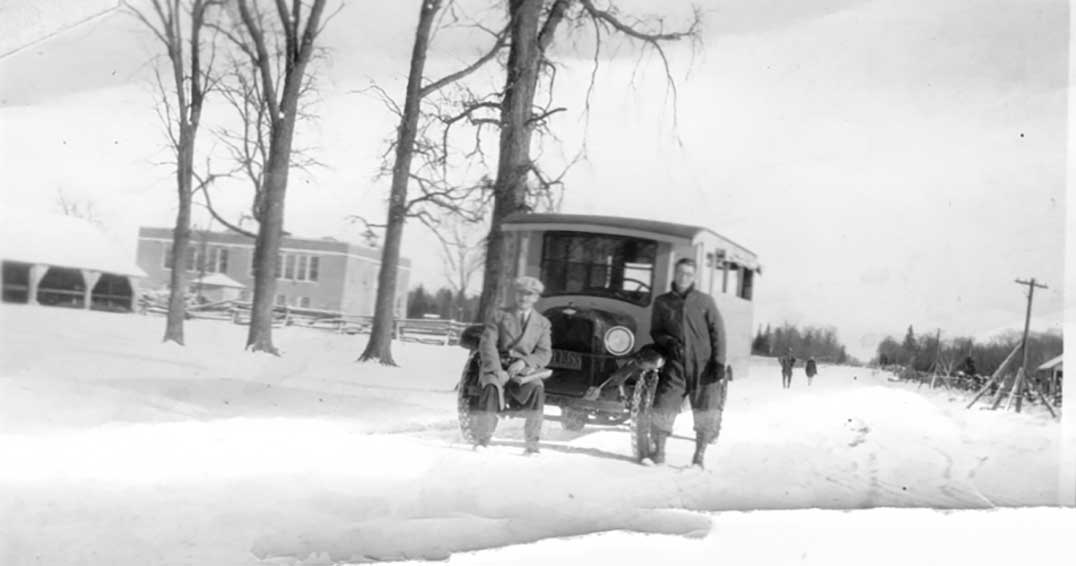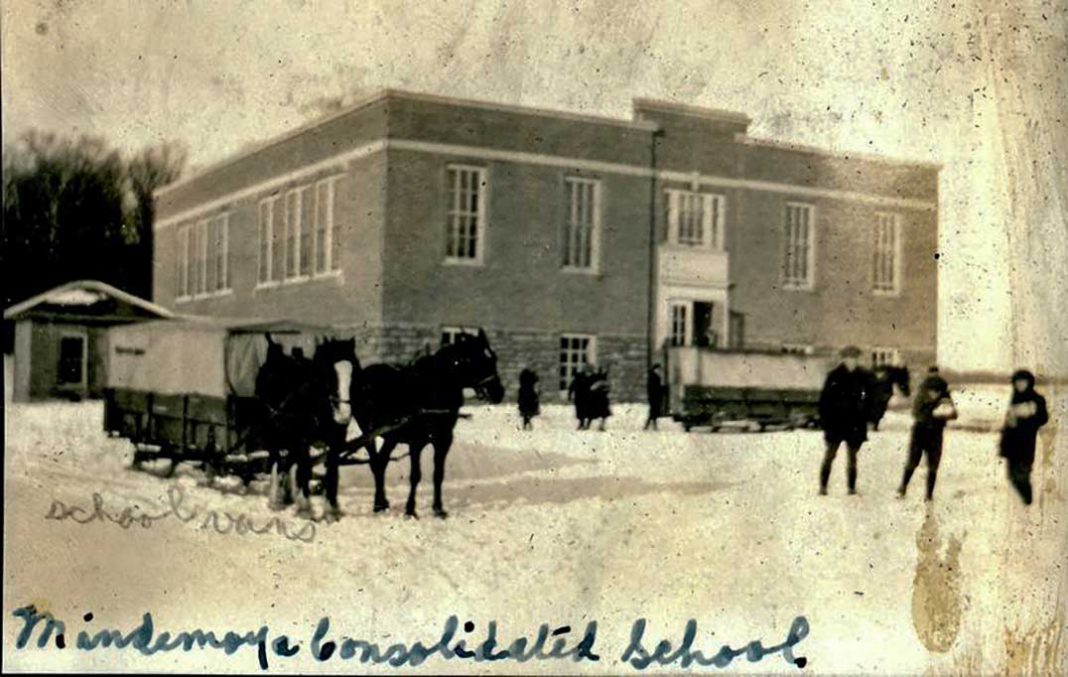MINDEMOYA—News that a motion is before the Central Manitoulin town council to send out requests for proposals for the demolition of the historic Mindemoya Old School building initiated an avalanche of memories flowing into The Expositor through emails, traditional mail and walk-ins, along with a number of phone calls from former and current Island residents expressing dismay over the Mindemoya Old School’s imminent demise.
“When one travels to Europe, much of the United States, South America or even some spots in Canada,” wrote former student Lynn Quesnel in a missive to The Expositor, “some of the most interesting and visited sites are those with some sort of historical significance. In Collingwood, where we spend part of the year, an old hotel that was in disrepair and had a very bad reputation, has been restored. Again, a couple of young entrepreneurs saw the potential in the beautiful old structure. Now it houses galleries, shops and a café. It is an extremely popular spot that draws people from all over.” The Quesnels went on to question the rush to demolish the historical structure and called for a rallying effort to convince council to pause before pushing the demolition button.
Among the photographs and memories that have come “over the transom,” in newspaper parlance, is the following excerpt supplied to The Expositor and taken from page 13 of the first Manitoulin Continuation School Year Book, circa June 1923: “Returning to the Manitoulin after several years’ absence, I decided that I should like to visit Mindemoya. I had been informed that with the coming of the railroad (to Little Current), the village had quickly grown into a town, and consequently, I was anxious to see it myself.
“As I passed along the road, the first thing that attracted my attention was the changed appearance of the school, instead of a one-story building, there was a fine two-story, eight-roomed school. The next thing was the school grounds. They now occupied about eight acres and as my eyes glanced across them I saw beds of flowers and vegetables, a basketball field, a football field and, last but not least, a baseball diamond. Looking over the sights nearer at hand I noticed the beautiful fences and walks.

“I made my way into the school and was met by a member of the staff who conducted me around and showed me the features of the building. In the hall there was a tablet with the names of the members of the staff since the school was built, at the head of the list were the names of Messrs. Purdy, Foran and Pierce.
“After looking around the public school rooms which were on the first floor, I was taken upstairs, where the four High School rooms were located. There were three classrooms and a science room. I was told that there were now one hundred and thirty-five students in attendance and that all the boys took agriculture in lieu of science. Before leaving the upper rooms, I asked about the ventilation facilities and was told that they were now controlled by a secret electric wire to the boiler room. Then I made my way out but took a look at the Community Hall, which was now turned into a gymnasium with complete equipment.
I went away happy that I had been able to recall so many familiar scenes and my thoughts turned to a line of poetry, ‘And the thoughts of men are widened with the process of the suns’.”
Since the history of Mindemoya Consolidated School is closely tied to the development of the educational system in the Mindemoya area we will begin with a brief outline of the history of education in this area.
The late Douglas Lanktree compiled a history of the building of the Mindemoya Old School with the assistance of an original article by Marvin Clarke, school records and assistance by Mike Smith and Mary Ann McCutcheon.
“The first settlers in this area of Carnarvon Township, the Vincers, McDonalds, Galbraiths and Elliotts arrived in 1872-73. They were joined in 1874 by the Hodgsons, Kings and Caddells in 1876 to establish a thriving pioneer community.
“School Section No. 1, Carnarvon, was organized in the year 1876 and a log school house was built to the north of the main intersection in 1877. This building burned and was replaced by another log building about 1880. As the population increased and the school became crowded an agitation was begun in 1893 to have the section divided with the dividing line being the twentieth sideroad which runs north and south through the town of Mindemoya. This proposal was turned down by Carnarvon council and a new frame building was built just west of the main intersection of the town.
“By 1918 the population growth made it necessary to hire a second teacher and consider expansion. Again there was a movement to divide the school section and build two schools. This time the movement was more successful. Council divided the school section, and two sets of trustees were elected with Mr. David Wyman acting as secretary for both boards. Plans were made for the building of two schools, one in the east and the other in the west end of the section.
“At this time a counter movement was established by some of the more progressive ratepayers with a plan to establish a Consolidated School comprising sections one and four to serve all pupils from grade one to grade twelve. This plan proved to be popular since it encompassed the improvement of high school education whereas previously some pupils took Grades 9 and 10 in the elementary school and others went to Owen Sound, Sault Ste. Marie etc. for further education.
“Plans were made, debentures were issued and the Consolidated school was built, reportedly the first and certainly one of the first Consolidated Schools in Ontario where more than one school section was served and pupils from grades one to twelve were educated in the same building.
“The (then-new Mindemoya) school opened in 1921 and one of the informants for this article, Mike Smith, being a bright ambitious young lad at that time, was the first student to enter the building on the morning of the day that it opened.
“With the opening of the Consolidated School, another first in the Province of Ontario became necessary. The first school buses to operate under contract were established to bring the pupils from the far corners of the joint sections. One of the contracts went to Finn McDermid who brought in the pupils from the west end of the section in a canvas covered wagon in summer and a canvas covered sleigh in winter, both drawn by horses. The second contract went to Lew Spry who used a democrat with a fringed top in summer and the covered sleigh in winter to bring in the east end pupils.”
Pat Costigan and Norma Hughson, along with other present and past members of the Central Manitoulin Historical Society, compiled an extensive list of historical nuggets, which were then forwarded on to The Expositor by Lynn Quesnel.
The Mindemoya Consolidated School was completed in 1922 by Charters and Brown, a construction firm from Sault Ste. Marie.
“In its first year of operation, the new school housed 35 to 40 high school level students.
The new school building originally served dual purposes. The rooms on the right were the public school while the rooms on the left comprised the continuation school (aka high school). A large recreation room was situated on the east side and on the west side, separated by the furnace room, was a hot lunch room, while on the right side there was a storage or supply room, according to an introduction in Central Manitoulin Councillor Linda Farquhar’s 1959 yearbook.
Each classroom had a cloakroom for outdoor clothing and the classroom windows were (and are) very large, which kept the rooms bright and reduced the need for artificial lighting. Likely there was many a daydream as students gazed out onto the fields outside on a sunny day.
Half of the basement of the Mindemoya Old School served as a community hall.
“My 89-year-old mother (Nola Haner) remembers playing badminton in the basement,” recalled one contributor. “She also remembers that after the war, a victory garden was planted and tended by students, with the school custodian taking over in the summer while the students were away.”
The first school buses or vans were sleighs drawn by teams of horses in the winter and covered wagons in the summer, as evidenced by a photograph supplied by a contributor.
The school fair was a very big event every year and once the arena next door was built, it was used to house the fair. The last of those school fairs was held in 1969, but then less than a decade later, Central Manitoulin Public School revived the school fair and it is, once again, a very big event for the Mindemoya community, complete with a parade through the streets from the school to the arena.
The playground was huge and included quite a lot of mixed forests. In the spring a favourite trick for the older boys was apparently secretly eating leeks at recess so the teacher would send them home because of the resulting odour.
In wintertime part of the schoolyard was used to play broomball and for skating.
By 1944, the heating system was updated and in 1950 the enrollment increased so much that the community hall in the basement was made into two more classrooms, one for Grade 7 and 8 and another to expand the Continuation School. By 1959 Central Manitoulin High School had been built, so the whole Old School became dedicated to the elementary level students.
In 1969 Manitoulin Secondary School was built in what was then called West Bay (now M’Chigeeng) and the Mindemoya Old School became the junior public school for Grades 1 to 4 and the old high school housed Grades 5, 8 and Kindergarten. When all the elementary grades moved to the senior school, the municipality took over ownership of the Mindemoya Old school and it housed the municipal offices and library and a plaque by the front door, placed there by the Carnarvon Council, indicates the building honours the memory of long-time Carnarvon Reeve and businessman Farquhar Anglin.
When then Reeve Tom Farquhar envisioned a new municipal building, part of the selling point was that the rental of the office space in the Mindemoya Old School building would offset the cost of the new building.
The building went on to be used for a variety of purposes such as dental offices, government offices, toy library, law office, health unit, among other things. The last tenant was a lawyer who made extensive renovations to her unit before being asked to vacate earlier this year.
Now the Mindemoya Old School lies silent and dark, without hydro or heating, waiting for its fate to be decided by the Central Manitoulin council at its September 28 meeting.



